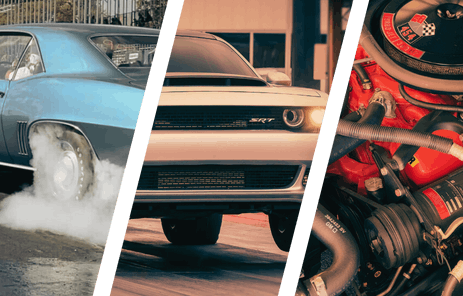We’re really loving modern muscle. Not only are these cars putting out some serious power in 50-state smog legal form, but with all the bells and whistles you’d come to expect from today’s luxury cars all the while looking pretty dang close to what their far-rougher-around-the-edges forefathers did. Who in the mid-1970s ever thought that we’d see the days where HEMI Challengers, BOSS Mustangs and SS Camaros would stalk the streets again?

So when our friends over at Motech Performance – our local Murrieta, California Mopar specialists – let us know they were going to be hooking up this fire engine red ’10 Challenger SRT8 with TTi Exhaust‘s header-to-tail pipe kit (PT#CH30HWCM), we had to stop on by and take a gander.
We’ve known about the craftsmen over at TTi for some time now. Their work is specialized specifically towards the Chrysler crowd, and do we mean specialized.
From true-fit headers, to mandrel-bent tubing, to better-looking-than-factory tips, TTi has made a name for themselves that is ironclad among Mopar lovers.
Their nickel-chrome, polished and regular ceramic coating touts a two-year warranty and nearly every product they sell has a 90-day limited warranty. And since the TTi kit relocates the factory O2 sensors, the package comes with an O2 extension harness to ward off any nasty “check engine” lights.
TTi’s 1 7/8-inch “Step” Headers require quite a bit of finagling, especially if you’re trying to accomplish this installation without the use of a car lift – which we don’t recommend. The headers come with two of TTi’s high density fiber metal core composite gaskets and plated header bolts.

Made from aircraft quality 304 stainless tubing, each header comes with a 3/8-inch thick laser-cut header and collector flange.
The rest of the exhaust system is made with 304 stainless, and come with MagnaFlow catalytic converters, SS T-bolt clamps, and a pair of MagnaFlow offset 24-inch mufflers. Best of all, each kit comes with a choice of Challenger or ‘Cuda cast-and-polished tips.
When it came time to remove the Challenger’s factory exhaust, things got a little tricky. Only the driver’s side tailpipe is modular and is able to be pulled out separately. The large sound resonators need to be tiled quite a bit to slide out without removing the back bumper, so removing the passenger side required some finesse.
Before removing the O2 sensors, it’s best to disconnect the battery (oh, and don’t close the trunk since it’s only opened electrically). With those out, the factory cats can be removed. Reaching all the bolts on the factory manifolds are equally as challenging, so TTi recommends removing the factory fuse/relay box on the passenger side and the air filter box (our Challenger had a Mopar CAI) and radiator reservoir on the driver’s side.
Surprisingly, with the factory manifolds out, the TTi headers slid in rather effortlessly. We tightened down all the header bolts to 25lbs. of torque, sandwiching in the provided TTi gaskets. The whole package comes with eight 3-inch stainless steel T-bolt clamps that tighten down the system as well as they look. TTi does recommend a dab of anti-seize on the threads of each of the O2 sensors before installing them to the X-pipe.

From there on, the rest of the assembly went together effortlessly. We only had to tweak and twist the pieces to get them aligned straight and aesthetically even. With our kit buttoned up, we attached the TTi-made retro-’70 Challenger-correct polished tips. The bodies are cast aluminum with an offset to not only follow the contour of the rear fascia, but give your already retro-looking new-gen Challenger awesome throw-back look.
With the SRT8’s new exhaust system complete, we reinstalled the fuse box and CAI, reattached the battery, and fired up the Challenger. With the clunky sound suppressors now gone and with high-flow Magnaflow cats and mufflers, the audible difference was clearly apparent. With a few quick raps of the throttle, we knew we had a different animal on our hands. While TTi is careful not to assign any blanket claims of horsepower gains with this kit, the immediate throttle response was undeniable.
As recommended by TTi, we drove the Challenger around for 20 minutes or so, just to clear out any moisture from the system. While driving, the new headers and larger diameter exhaust burbled nicely while at cruising speeds, but reverberate like a HEMI-powered Challenger ought to when you mash on the gas…and that’s why we got the modern Mopar in the first place.

You might also like
SRT Is Back — Can HEMI Hellcats and Demons Be Far Behind?
The Street & Racing Technology Division is back and Stellantis and it is being run by Tim Kuniskis, a true gearhead. This confirms what we reported in April, that the HEMI would be back and the new Charger, tru



